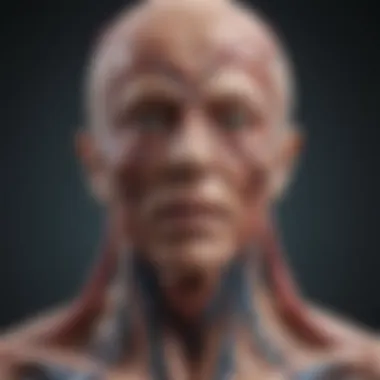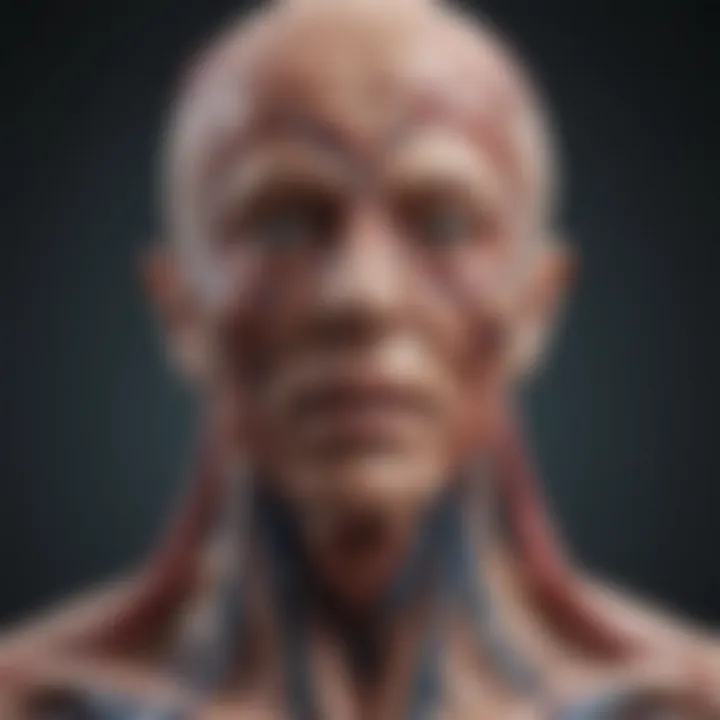Understanding Aneurysms: Definition, Types, and Treatments


Intro
Aneurysms are significant medical conditions that require thorough understanding due to their potential consequences. An aneurysm occurs when the wall of a blood vessel weakens, leading to a bulge or dilation. This condition can manifest in various locations within the body, with the most common sites being the aorta, brain, legs, and spleen. Understanding the nuances of aneurysms—including their definitions, underlying causes, and treatment options—is crucial not only for healthcare professionals but also for patients and their families.
The examination of aneurysms extends beyond mere definition. It involves a careful exploration of the various types that exist, the risk factors that may contribute to their formation, and the symptoms that may arise when one occurs. Diagnostics, medical management, and surgical interventions also play essential roles in addressing aneurysms. Ultimately, providing an insightful overview of these elements can help demystify a complex health issue.
Prelude to Aneurysms
Aneurysms are significant medical conditions that can have severe consequences if left untreated. Understanding what aneurysms are, including their definitions, types, causes, and treatments, is crucial not only for medical professionals but also for patients and their families. This section will delve into the foundational knowledge related to aneurysms, providing an essential backdrop for discussing more complex aspects later.
The relevance of exploring aneurysms lies in their potential for rupture, leading to life-threatening emergencies. Aneurysms can occur in various parts of the body, primarily affecting the brain and the aorta, which is the largest artery. Consequently, knowledge about aneurysms equips individuals with the ability to recognize symptoms and seek appropriate help.
For students and professionals in the medical field, grasping the complexities of aneurysms enhances their ability to contribute to patient care. Additionally, educating the public on this subject can promote early detection and effective management.
Defining Aneurysm
An aneurysm is a localized dilation or bulge in a blood vessel due to a weakness in the vessel wall. This condition can occur in arteries or veins and may vary in size, often presenting few symptoms until it becomes critically large or ruptures. The most common forms of aneurysms occur in the aorta and brain.
Several types of aneurysms include:
- Cerebral aneurysms, which form in the blood vessels of the brain.
- Aortic aneurysms, affecting the aorta, categorized further into ascending and descending types.
- Peripheral aneurysms, which can occur in arteries leading to the limbs.
Understanding the definition is the first step toward recognizing the importance of monitoring these conditions.
Historical Context
The study of aneurysms dates back centuries, with early descriptions found in ancient medical texts. However, it was not until the 19th century that significant advancements were made in understanding their formation and risks. Notable figures in medicine began documenting cases of aneurysms, noting their implications and mortality rates upon rupture.
Historically, medical treatment was limited, with surgery being a last resort due to risks involved. Over the decades, advances in surgical techniques and imaging have greatly improved outcomes for patients with aneurysms. Understanding this historical context allows readers to appreciate the evolution of treatment and management options available today.
"The journey from primitive understanding to modern medical practices regarding aneurysms reflects the broader advancements in health sciences."
In summary, the introduction to aneurysms provides a critical framework for understanding their implications in health contexts. With detailed definitions and a perspective on their historical evolution, readers are encouraged to further explore the types, causes, and treatments associated with this condition.
Types of Aneurysms
Understanding the types of aneurysms is crucial for both medical professionals and patients. Different types reflect diverse anatomical locations, each presenting unique challenges in terms of diagnosis and treatment. Learning about these types can aid in recognizing symptoms, assessing risks, and developing effective management strategies. It also highlights the complexities and variations in this condition, which can significantly affect an individual’s health outcomes.
Cerebral Aneurysms
Cerebral aneurysms occur in the brain's blood vessels. They can present serious risks, such as rupture leading to a stroke. Recognizing cerebral aneurysms is essential since early detection often determines treatment success. Symptoms may also vary, making diagnosis challenging. The awareness of potential symptoms, such as headaches or vision changes, is vital. Understanding this type can help clinicians provide prompt interventions.
Aortic Aneurysms
Aortic aneurysms involve the aorta, the body's main artery. They can be divided based on location, leading to two subsections: aneurysms of the ascending aorta and aneurysms of the descending aorta.
Aneurysms of the Ascending Aorta
Aneurysms of the ascending aorta are found near the heart. These are significant because of their proximity to critical structures. The key characteristic of ascending aortic aneurysms is that they often develop silently. This means that symptoms may not be obvious until a serious event occurs, like a rupture. Due to this hidden nature, they could present a high risk without prior warning.
A unique feature of these aneurysms is their association with conditions like Marfan syndrome, which can lead to a progressive dilation. The advantages of recognizing these aneurysms early include improved surgical options. However, the disadvantage is that many patients may ignore early signs. This topic is crucial for understanding the types of aortic aneurysms and aids in addressing pervasive health issues related to them.
Aneurysms of the Descending Aorta
Aneurysms of the descending aorta occur further from the heart, in the body’s thoracic and abdominal regions. The significance of these aneurysms lies in their potential to grow large before symptoms develop. A notable characteristic is that they often relate to conditions such as atherosclerosis and hypertension. Addressing these factors can help manage or prevent this type of aneurysm.
The unique feature is that, unlike ascending aneurysms, they may often remain asymptomatic until significant vascular compromise occurs. The main advantage of understanding aortic aneurysms' development patterns is enhanced awareness of preventive measures. The disadvantage attaches to the potential for misdiagnosis, as their effects can mimic other abdominal conditions. Recognizing the distinction here is vital for effective management.
Peripheral Aneurysms
Peripheral aneurysms form in arteries outside the central region of the body, often affecting the arms and legs. They are usually less common but can be equally dangerous. The main issue with peripheral aneurysms is that they may go unnoticed until complications arise. The consequences of this oversight can include limb ischemia or rupture.
Recognizing the symptoms, which may include pain or swelling in the affected limb, is crucial. Understanding these types can inform strategies for patient education and improve clinical outcomes.
Causes of Aneurysms
Understanding the causes of aneurysms is crucial for both prevention and management. Their development can often be traced back to a combination of genetic predisposition and lifestyle choices. Recognizing these causes can help individuals and medical professionals identify at-risk populations and encourage early interventions. Initiating discussions about aneurysm causes informs readers of modifiable and non-modifiable risks, fostering better awareness and proactive health strategies.
Genetic Factors
Genetic factors play a significant role in the development of aneurysms. Certain inherited conditions are linked to structural weaknesses in blood vessel walls. For instance, disorders such as Marfan syndrome and Ehlers-Danlos syndrome increase vulnerability to aneurysms. Individuals with a family history of aneurysms may be at heightened risk, suggesting genetic predisposition. Understanding these hereditary traits is essential for identifying those who might benefit from regular monitoring or preventive measures.
Lifestyle Factors


Lifestyle choices can significantly influence the risk of developing aneurysms. A few key factors contribute to this.
Smoking
Smoking is a major risk factor for aneurysm formation. The toxic substances in cigarettes damage the blood vessels, making them more likely to weaken over time. This aspect of smoking underscores its detrimental role in cardiovascular health. The unique feature of smoking is its direct association with accumulating arterial injury, which contributes to the process leading to aneurysms. Furthermore, quitting smoking provides considerable benefits such as improving cardiovascular function over time.
Hypertension
Hypertension, or high blood pressure, is another critical contributor to aneurysms. Elevated blood pressure exerts excessive force against arterial walls, which can lead to their weakening. This characteristic of hypertension makes it a common choice in discussions about aneurysm causes. The unique feature of hypertension lies in its manageability through lifestyle changes and medications. Effective control of blood pressure can significantly reduce the risk of aneurysm development.
High Cholesterol
High cholesterol levels also contribute to the formation of aneurysms. Elevated levels of low-density lipoprotein (LDL) cholesterol result in plaque buildup in the arteries. This accumulation narrows the arteries and can increase the risk of developing aneurysms. The unique feature of high cholesterol is its reversible nature; dietary changes and medications can effectively lower cholesterol levels. Thus, understanding and managing cholesterol is vital in mitigating the risk of aneurysms.
Injury and Infection
Injury and infection may also lead to the formation of aneurysms. Traumatic injuries to the blood vessels can create weaknesses, making the aorta and other arteries susceptible. Additionally, certain infections like syphilis and bacterial endocarditis can compromise vascular integrity. These conditions highlight the need for careful monitoring and management of injuries and infections to prevent subsequent aneurysm development.
"Preventive measures and lifestyle changes can greatly reduce the risk of aneurysms, demonstrating the power of informed health decisions."
In summary, recognizing both genetic and lifestyle factors can greatly enhance awareness of aneurysm risk. Understanding the specific contributions of smoking, hypertension, high cholesterol, and events like injuries or infections provides a comprehensive perspective on prevention and management of this serious health issue.
Risk Factors Associated with Aneurysms
Understanding the risk factors associated with aneurysms is crucial for prevention and early intervention. Aneurysms can develop silently, often without symptoms until a critical situation arises. By identifying specific risk elements, individuals and healthcare providers can collaborate on effective management strategies. In this section, we will delve into two primary aspects: age and gender, and family history, both of which play significant roles in the development of aneurysms.
Age and Gender
Age is a fundamental risk factor when it comes to aneurysms. The likelihood of developing an aneurysm increases as individuals grow older. Statistically, people over the age of 40 are at a greater risk. Similarly, gender plays a notable role. Research indicates that men are more likely than women to experience aneurysms, particularly aortic aneurysms. This disparity can be attributed to various biological factors, including hormonal influences and differences in vascular structures.
The presence of an aneurysm typically escalates with advancing age. For men, the risk notably rises after their 50s. In women, the risk becomes more pronounced post-menopause. This observation points to the possible protective role of estrogen before menopause. Regular medical check-ups can help monitor and manage risks for different age groups and genders, ensuring appropriate interventions when necessary.
Family History
Family history is another significant risk factor that cannot be overlooked. Individuals with relatives who have experienced aneurysms, particularly a familial history, are at an increased risk. Genetic predispositions may influence the structural integrity of blood vessels, making them more susceptible to aneurysms.
When assessing familial risk, it is important to consider specific conditions. A history of connective tissue disorders, such as Marfan syndrome or Ehlers-Danlos syndrome, heightens aneurysm risk. These disorders affect the strength and elasticity of blood vessels, which increases the likelihood of aneurysms developing.
To summarize, awareness of risk factors like age, gender, and family history is crucial. Understanding these factors not only informs preventive strategies but also equips individuals with the knowledge to seek timely medical attention. The interrelation of these elements emphasizes the necessity for personalized medical guidelines based on risk assessments.
Symptoms of Aneurysms
Understanding the symptoms of aneurysms is vital for early detection and treatment. Many aneurysms do not present noticeable symptoms until they become serious. Therefore, recognizing potential warning signs can significantly impact the outcome for individuals. By knowing what symptoms to look for, patients can seek medical assistance more promptly, leading to better prognoses. Symptoms can also vary depending on the type of aneurysm, which further emphasizes the importance of this knowledge.
Common Symptoms
Common symptoms associated with aneurysms may often be vague or mistaken for other medical issues. For many aneurysms, especially aortic and peripheral types, symptoms can include:
- Pain: This can occur in the back, abdomen, or chest, depending on the aneurysm type.
- Pulse: A noticeable heartbeat in the abdomen may be detected.
- Pressure sensations: Some may experience an unusual feeling of pressure in the specific area of the aneurysm.
- Nausea and vomiting: This may accompany pain or sudden discomfort.
- Fatigue: Increased fatigue or weakness can occur, often overlooked.
It is essential to seek medical attention if these symptoms arise, as they could signify a growing aneurysm.
Symptoms by Type
Cerebral Symptoms
Cerebral aneurysms, located in the brain, often present distinct symptoms. A key characteristic of these symptoms is their sudden onset, which might indicate a serious condition. Common cerebral symptoms include:
- Severe headache: Often described as the worst headache ever experienced.
- Blurred vision or double vision: Visual changes are significant indicators.
- Neurological signs: This may include weakness in limbs or facial drooping.
These symptoms contribute to the overall goal of understanding aneurysms—early detection can lead to timely interventions, potentially preventing serious complications like hemorrhage. Recognizing cerebral symptoms is beneficial because they offer critical clues to the nature and location of the aneurysm.
"Cerebral symptoms can often be the first sign of an impending rupture, making awareness crucial."
Aortic Symptoms
Aortic aneurysms, affecting the aorta, also exhibit specific symptoms related to their location. A distinguishing feature of these symptoms is that they can sometimes be detected during physical examinations, such as:
- Chest pain: This may feel like a deep, penetrating pressure.
- Back pain: Patients may also report discomfort in their back or side.
- Shortness of breath: Difficulty breathing or feeling winded is common.
The symptoms from aortic aneurysms highlight their potentially life-threatening nature. Awareness of these signs is critical, as the sudden rupture can lead to significant internal bleeding. Knowing the symptoms helps in early diagnosis, crucial in managing the risks involved.
Diagnosis of Aneurysms
Diagnosing an aneurysm is crucial for effective management and treatment. Early detection can greatly affect patient outcomes. This section discusses the various methods used in the diagnosis of aneurysms, focusing on imaging techniques and physical examinations. These approaches provide healthcare professionals with essential insights, allowing for timely interventions and reducing the risk of complications like rupture.


Imaging Techniques
Imaging techniques play a fundamental role in diagnosing aneurysms. They allow for visualization of blood vessels and the detection of abnormalities. Each technique has its specific advantages and applications.
MRI
Magnetic Resonance Imaging (MRI) is a non-invasive imaging technique that uses strong magnets and radio waves to create detailed images of organs and tissues. In the case of aneurysms, MRI can provide clear images of blood vessels without the need for ionizing radiation. One of its key characteristics is its ability to visualize soft tissues with great clarity, making it particularly beneficial for detecting cerebral aneurysms.
However, MRI has some disadvantages. It is less effective for imaging calcium deposits, which can be critical in evaluating aortic aneurysms. The procedure can also take longer than other imaging methods, leading to discomfort for some patients.
CT Scans
Computed Tomography (CT) scans are widely used in the diagnosis of aneurysms due to their speed and effectiveness. This imaging technique involves taking multiple X-ray images from different angles, which are then assembled into a cross-sectional view of the body. CT scans are particularly good at quickly identifying aortic aneurysms and can often be done in emergency situations.
The unique feature of CT scans is their capability to produce rapid images, which is crucial in trauma cases. However, CT scans do expose patients to ionizing radiation, which might be a concern, especially for individuals requiring multiple studies over time.
Ultrasound
Ultrasound uses sound waves to create images of the body and is an important diagnostic tool for aneurysms. It is particularly useful for monitoring abdominal aortic aneurysms. One major advantage is that it is a radiation-free method, making it safer for regular use in patients under active surveillance. Ultrasound can also be performed relatively quickly and is cost-effective.
Nonetheless, ultrasound has limitations. Its effectiveness can decrease with obesity or excessive gas in the abdomen, making it harder to visualize some aneurysms compared to CT or MRI.
Physical Examination
Physical examination is another vital component in the diagnosis of aneurysms. Physicians often assess symptoms and perform a hands-on examination to identify suspicious signs. For example, a pulsating mass in the abdomen may indicate an abdominal aortic aneurysm. Healthcare providers take patient history into consideration to better understand risk factors and symptoms. While not a definitive test, the physical examination helps guide further imaging and treatment decisions.
Treatment Options for Aneurysms
Treatment of aneurysms is critical. It can determine the quality of life for patients and their risk of severe complications. Understanding these options is essential for anyone who may be affected by this condition. Treatment strategies vary based on the type and location of the aneurysm, as well as the patient's overall health. Clinicians often consider both preventive and responsive measures to address the condition adequately.
Monitoring and Observation
Monitoring is often the first approach to managing aneurysms, particularly when symptoms are absent. This strategy focuses on regularly checking the size and growth of the aneurysm to assess risks. Doctors may utilize imaging techniques such as MRI or ultrasound during check-ups.
Through observation, healthcare providers can identify any changes that may necessitate treatment. It allows patients to avoid unnecessary surgical risks while still being monitored closely. This method is especially useful for small, asymptomatic aneurysms where immediate intervention may not be warranted. Regular follow-ups help maintain awareness of the condition's evolution and ensure timely actions if required.
Medications
Medications are another treatment avenue for aneurysms. They aim to manage risk factors that can worsen the condition or lead to complications. Two significant categories of drugs often come into play: blood pressure medications and cholesterol lowering drugs.
Blood Pressure Medications
Blood pressure medications play a crucial role in the management of aneurysms. Antihypertensive agents help control high blood pressure, a significant risk factor for aneurysm progression and rupture. Keeping blood pressure within a normal range is vital for reducing stress on the blood vessel walls. This therapy is particularly beneficial for patients with a history of hypertension.
These medications, such as beta-blockers or ACE inhibitors, lower blood pressure without causing drastic fluctuations. They provide a steady approach to managing cardiovascular health. However, patients must be aware of potential side effects, such as fatigue or dizziness, which may occur in some cases. Physicians often balance these benefits and risks when prescribing blood pressure medications.
Cholesterol Lowering Drugs
Cholesterol lowering drugs are another key aspect of aneurysm management, particularly for those at risk of vascular diseases. Statins, for instance, can help lower LDL cholesterol levels and stabilize arterial plaques.
The key characteristic of cholesterol lowering drugs is their ability to decrease the likelihood of atherosclerosis. This condition can create additional pressure on the blood vessels and potentially exacerbate aneurysm complications. Regular use of these medications is especially important for patients with elevated cholesterol levels.
While beneficial, one must consider potential interactions with other drugs and side effects like muscle pain or digestive issues. The overall goal is to enhance vascular health and reduce aneurysm risks while being vigilant about medication effectiveness.
Surgical Interventions
In specific cases, surgical interventions are necessary to treat aneurysms effectively. These procedures can prevent complications such as rupture. The most common surgical treatments include clipping for cerebral aneurysms and stenting for aortic aneurysms.
Clipping for Cerebral Aneurysms
Clipping for cerebral aneurysms involves placing a small clip at the base of the aneurysm. This method is helpful in preventing the aneurysm from bleeding. The surgery is often performed under general anesthesia. A neurosurgeon makes an incision in the skull to reach the brain. This invasive procedure requires careful consideration and is generally recommended for larger or symptomatic aneurysms.
This surgical approach's main characteristic is its permanence. Once the clip is in place, the aneurysm cannot bleed. However, recovery can be prolonged, and risks such as infections or neurological deficits exist.
Stenting for Aortic Aneurysms
Stenting is used primarily for aortic aneurysms. This less invasive procedure involves placing a stent graft into the aorta. It supports the artery wall and keeps the blood flow normal while reducing strain on the aneurysm. Endovascular stenting offers a shorter recovery period compared to traditional surgeries.
The key feature of this approach is its minimally invasive nature. Many patients experience less pain and a quicker return to daily activities. However, stent placement relies heavily on the aneurysm's characteristics. There could be risks of graft failure or complications over time.
To conclude, treatment options for aneurysms are vital for managing the condition effectively. They range from monitoring to medical therapies and surgical solutions, each tailored to a patient's specific situation. Understanding these options can improve health outcomes and enhance patient well-being.
Complications Associated with Aneurysms
Understanding the complications associated with aneurysms is crucial for both medical professionals and patients. These complications can significantly impact patient outcomes and dictate treatment paths. Recognizing potential complications helps in early intervention and may prevent disastrous consequences following aneurysm formation. When discussing aneurysms, it is essential to consider the risks and severe outcomes that can arise, thus providing a full picture of this medical condition.


Rupture
Rupture is one of the most alarming complications of an aneurysm. When an aneurysm ruptures, it leads to sudden and severe health risks, often resulting in critical situations. This occurrence can happen without warning, depending on various factors, including the size of the aneurysm and its location. The rupture of an aneurysm frequently induces massive internal bleeding, which can be fatal if not addressed swiftly.
The statistical likelihood of rupture varies among different types of aneurysms. For instance, cerebral aneurysms have a higher risk of rupture, especially in individuals with elevated blood pressure or other risk factors. Symptoms commonly associated with a rupture include:
- Sudden, severe headache
- Nausea or vomiting
- Loss of consciousness
- Vision disturbances
Immediate medical attention is paramount if someone exhibits these symptoms, as quick action can save lives. Treatment options following a rupture are often urgent and invasive, focusing on both stopping the bleeding and repairing the damaged vessel. Failure to respond in timely fashion to a ruptured aneurysm can lead to irreversible brain damage or death.
Hemorrhage
Hemorrhage is both a direct result of aneurysm rupture and can also occur in other contexts. For instance, an aneurysm may leak before rupturing, creating a hematoma that can compress surrounding tissues. Hemorrhagic complications can be particularly precarious, as uncontrolled bleeding may not only stem from the aneurysm itself but also from surrounding vascular structures.
The severity of hemorrhage is primarily determined by the location and size of the aneurysm. Cerebral hemorrhages can lead to significant neurological deficits, while aortic hemorrhages may result in life-threatening shock. Patients may present with various symptoms, including:
- Sudden weakness or numbness
- Confusion or altered consciousness
- Rapid heart rate and low blood pressure
Treatment for hemorrhage can range from medical management in less severe cases to surgical intervention in more critical situations. It is imperative for healthcare providers to monitor patients with known aneurysms vigilantly for signs of hemorrhage to mitigate risks.
In summary, the complications associated with aneurysms, particularly rupture and hemorrhage, highlight the necessity for ongoing monitoring and proactive healthcare measures. Early intervention can often dictate outcomes favorably.
For further detailed research about aneurysms and their complications, resources such as Wikipedia and Britannica are beneficial.
Living with Aneurysms
Living with aneurysms can present various challenges that require diligent management and proactive care. The understanding of this condition plays a crucial role in enabling patients to lead a fulfilling life. With the right lifestyle modifications and regular monitoring, individuals with aneurysms can minimize risks and enhance their overall well-being. This section delves into essential lifestyle changes and the importance of consistent medical oversight.
Lifestyle Modifications
Dietary Changes
Dietary changes are important for individuals living with aneurysms. A diet that focuses on heart health can contribute significantly to maintaining a stable condition. It often emphasizes fruits, vegetables, whole grains, and lean proteins, while minimizing saturated fats and trans fats. The key characteristic of this approach is its ability to lower blood pressure and manage cholesterol levels, both of which are crucial in avoiding complications linked with aneurysms.
A unique feature of dietary changes is the incorporation of omega-3 fatty acids found in fish. These beneficial components can reduce blood vessel inflammation and promote better circulation. In addition, a plant-based diet may provide antioxidants that support vascular health. However, it is vital for patients to consult healthcare professionals to tailor an appropriate regimen that caters to their specific needs.
Exercise Considerations
Exercise considerations are equally significant for those living with aneurysms. Regular, moderate physical activity can help reduce hypertension and improve cardiovascular health, contributing to better management of the condition. The key characteristic of incorporating exercise is the potential to enhance overall physical and mental well-being. Activities such as walking, swimming, and yoga can be beneficial without placing excessive strain on the body.
One unique feature of exercise is its ability to aid in weight management, which is an important factor in reducing the risks associated with aneurysms. Keeping a healthy weight is often recommended; however, it is essential for individuals to consult with their healthcare provider before starting any new exercise routine. This ensures that the chosen activities align with their health status and do not pose unnecessary risks.
Regular Check-Ups
Regular check-ups are vital for individuals affected by aneurysms. Consistent monitoring allows for early detection of any potential changes in the condition. Healthcare providers can assess the aneurysm’s size and growth, guiding treatment decisions appropriately. This proactive approach can help in managing risks associated with aneurysms effectively, reinforcing the importance of keeping scheduled appointments vitally.
Living with aneurysms requires awareness and action. By making thoughtful lifestyle adjustments and committing to regular medical check-ups, individuals can navigate their condition with a greater sense of control and confidence.
Future Directions in Aneurysm Research
Research in aneurysms is crucial for advancing medical understanding and improving treatment options. As science evolves, so do the methodologies and insights regarding aneurysms. This section explores two significant avenues: emerging treatments and genetic research.
Emerging Treatments
Emerging treatments for aneurysms are at the forefront of medical innovation. As traditional surgical methods are refined, new approaches are being explored to enhance safety and efficacy. These treatments include newer stent designs and minimally invasive techniques, which have shown promise in clinical trials.
- Endovascular options are gaining traction, allowing for repairs from within the blood vessels. This can reduce recovery times and lower the risk of complications compared to traditional surgery.
- Drug-eluting devices may provide a dual approach by delivering medication directly to the site of the aneurysm, helping to manage blood pressure and prevent further expansion.
- Biologic therapies are also in development. These therapies could promote vascular healing and regeneration, potentially reversing aneurysmal changes altogether.
Incorporating these emerging treatments into clinical practice requires rigorous testing and validation but offers hope for patients facing aneurysm-related risks.
Genetic Research
Genetic research holds significant potential in understanding the predispositions to aneurysms. It investigates how genetic factors contribute to aneurysm formation and progression. This avenue of research opens the possibility for:
- Identifying at-risk individuals by examining family histories and genetic markers. This can empower targeted screening strategies, leading to timely interventions.
- Understanding pathophysiology at a molecular level, which could unveil new therapeutic targets.
- Personalized medicine approaches, whereby treatment strategies are tailored based on a patient's genetic makeup.
By comprehensively studying the genetic basis of aneurysms, researchers aim to not only improve diagnostic tools but also pave the way for innovative treatment strategies that align with an individual’s genetic profile.
Epilogue
The conclusion serves a vital role in summing up the intricate discussions around aneurysms that this article has explored. It allows readers to crystallize their understanding of various aspects, from definitions to types and treatments. By providing a concise yet comprehensive review of key points, we emphasize the complexity of aneurysms while also making the topic more digestible.
Vast knowledge about aneurysms is crucial for several reasons. Understanding this medical issue can empower individuals to recognize symptoms early, promote healthier lifestyles, and foster open discussions with healthcare providers. Furthermore, awareness of risk factors can lead to preventive measures, potentially reducing the incidence of these life-threatening conditions.
A strong grasp of treatments, both surgical and non-surgical, equips patients and caregivers with the necessary tools to make informed decisions in collaboration with medical professionals. This chapter reflects on the path forward in aneurysm awareness, encouraging ongoing education and vigilance.
Summary of Key Points
- Aneurysms represent significant health risks that require comprehensive understanding and proactive management.
- Various types of aneurysms have distinct characteristics impacting diagnostics and treatment strategies.
- Key causes and risk factors include genetic predispositions, lifestyle choices such as smoking and hypertension, and external factors like injuries.
- Recognizing symptoms specific to aneurysm type can lead to timely interventions.
- Diagnostic techniques provide critical insights, allowing for effective management plans.
- Treatment options range from monitoring to medication and various surgical interventions, tailored to individual patient needs.
- Future research aims to unveil emerging treatment modalities and enhance genetic understanding for better prevention and care.
By synthesizing these important aspects of aneurysms, this conclusion underscores the necessity of ongoing engagement with this important health topic.







